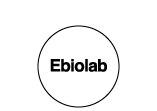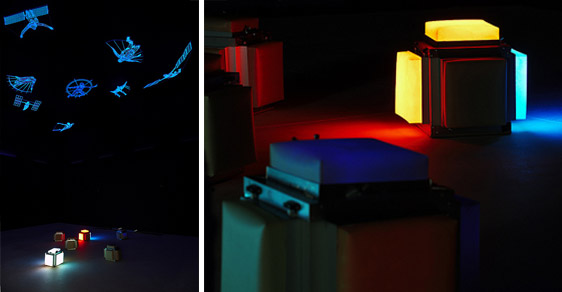

Image down: © LABoral - Autor Marcos Morilla.
POEtic-Cubes, 2007/08
Moreno Aróstegui, J. Manuel
Paricio, Raquel
Interactive installation
I am in the dark space, and silence. In the background I can see a luminous mass of intense colours. It is the mother cell. I head towards her and then the process of cellular self-replication unfolds. New cells are born from the original nucleus, each adopting the same colour code, the same genetic code, as the first cell. Through a complex process, guided by my presence in the presence of other users, they will move to form an organism, an entity that will have a function, a behaviour, something in front of it, something behind it, a shape in space.
With my movements, I shape that form, which has just surrounded me, to make me its centre. I move to the right and the organism is shaped with my body. I lean at any angle, I move an arm, or a leg, and the shape adapts itself to my movements. New sculptural shapes and colour mutations follow as a result of the cross, of the interaction among users and among the autonomous entities themselves. I try to move a cell with my hands, which then transmits the information to those adjacent to it, acting from a distance, as if I were sliding through an un-formed mass or liquid where the particles closest to me transmitted my strength, my desire, to every other cell, moving them away from my centre of gravity.

This way, moving me and that liquid, floating space, the organism forms its appearance adapting itself to its environment, to the movements of all of those who participate in the experience.
When its energy runs out, it returns autonomously to its energy recharging source, and then begins the cycle once more.
This organism exists as the result of cellular cooperation, where each element on its own cannot carry out the work of the group, where each unit is essential to the action and shape of the whole.
Finding out how that spontaneous order occurs, or in other words, how it develops from one cell, is the enigma of life.
The robotic installation POEtic-Cubes has been conceived so that this entire developmental process takes place. P.O.E. stands for Phylogenesis, Ontogenesis and Epigenesis— that is, Evolution, Development and Learning, the basic principles of all living beings. Artificial life uses them as a model to solve everyday conflicts or needs, learning from how nature applies its laws to continue evolving. Thus, through a bio-inspired process, we learn from biological laws to apply them to our prosthetic environment, thus enabling the artificial environment we create as an extension of our body to adapt itself to us.
The installation as a complex bio-inspired system proposes the idea of adaptive environments as systems of perception through autonomous systems that manifest the phenomenon of adaptation, emergence and self-organization.
- Technology and Digital Art
- www.elsevier.com
- Adaptive Methods for the Development of Interaction in Artistic Installations
- El Pensament en Perill? l’assaig com a forma oberta i crítica
- www.isi.it/index.php
- COMPLEX SYSTEMS NETWORK OF EXCELLENCE
- RES-QUALIA:EVOLVABLE ART
- www.poetictissue.org
- www.res-qualia.net
- Publicaciones. Bibliografía
- Jon McCormack and Alan Dorin. “Art, Emergence, and the Computational Sublime.
